The Victorian era started with the reign of Queen Victoria. The Victorian era lasted from 1837 to 1901. In these 63 years, British Empire grew into an industrial powerhouse.
They saw massive advancement in their railway, engineering, and trade sectors. This allowed them to produce much of the world’s iron, steel, coal, and textiles. The Victorian era brought a lot of changes in Britain’s economy, social structure, and culture.
But one of the most exciting things about the Victorian era is its fashion and clothing. Most people find Victorian fashion quite fascinating. The dress used by the upper-class people in that era is fashionable in modern days too.
Click here if you are looking for a victorian-inspired dress for yourself.
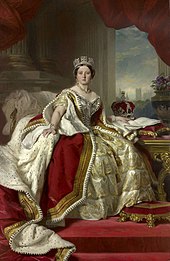
Victorian Fashion
Victorian fashion went through a lot of changes during that era. Every decade of that era saw different fashion trends and clothing styles. It was more noticeable in upper-class families.
After the invention of the sewing machine, the clothes became more complex. The invention of synthetic dyes helped to create vibrant fabric colors. Victorian fashion drew a perfect picture of the decorative and visual style of the Victorian era.
Both Victorian men’s fashion and Victorian women’s fashion trends changed over the decades. But the women’s fashion trend and clothing are more well documented than men’s. The clothing choice was also different from the upper class to the working-class people. People could quickly identify the social class of any person from their clothing.
There is very little information about working-class people’s clothing. The same is true for other fashion items like shoes, jewelry, and accessories.
Women’s Clothing
Victorian clothing styles reflected their social class. Most middle class and upper-class women did not have to do any household chores. So, their clothes evolved based on their sedentary lifestyle. The upper-class women often wore a tightly laced corset over a bodice. For the lower body, they wore a skirt over layers of petticoats. The Skirts had many embroideries and trims. Middle-class women also wore similar clothes. But the clothes had fewer decorations. Back then; this type of clothing was a symbol of wealth.
Victorian dresses of women go through some changes over time. The neckline, sleeves, boning, and silhouette made their dress unique. Changes in these areas gave a new look to the clothing style every decade.
If you are looking for a Victorian dress for yourself, you can check this article.
Neckline
In the Victorian era, women wore a low shoulder neckline called Bertha. These necklines exposed their shoulders. Victorian era’s Bertha was trimmed over with 3-6 inches deep lace flounce. Only upper and middle-class women used these necklines. The poor women were not allowed to show much of their skins.
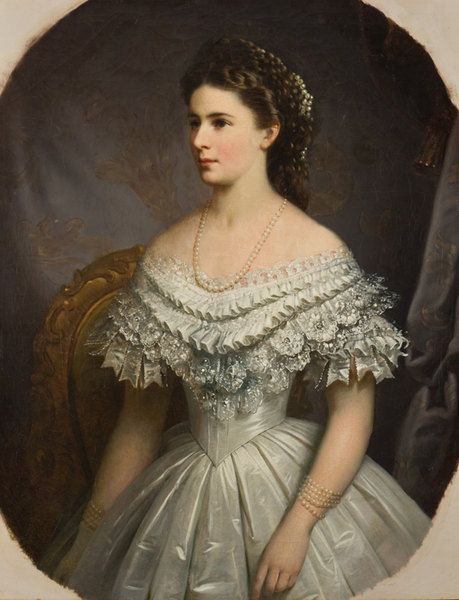
During the Victorian era, the neckline design went through some minor changes. In the beginning, the neckline was straight. Then the V-shaped neckline came along. At the end of the Victorian era, high neckline dresses also became popular.
Sleeves
There were three popular types of sleeves in the Victorian era. The most common was tightly fit full sleeve. It matched with the tight corset design.
Other types of sleeves were short sleeves. These types of sleeves came with massive bell shape crinolines.
There were other types of sleeves named Engageantes. They were false sleeves made of lace, linen, or lawn. These types of sleeves were worn under the sleeves. They were easy to remove or attach.
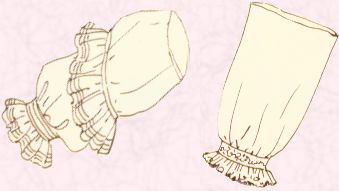
Boning
The corset of the Victorian era used boning to maintain the shape. Corsets were an important part of the victorian costume. The corset during that era emphasized the small waist. The boning gave the corset that tight tiny waist look. The corset with boning worked as a waist trainer for many women.
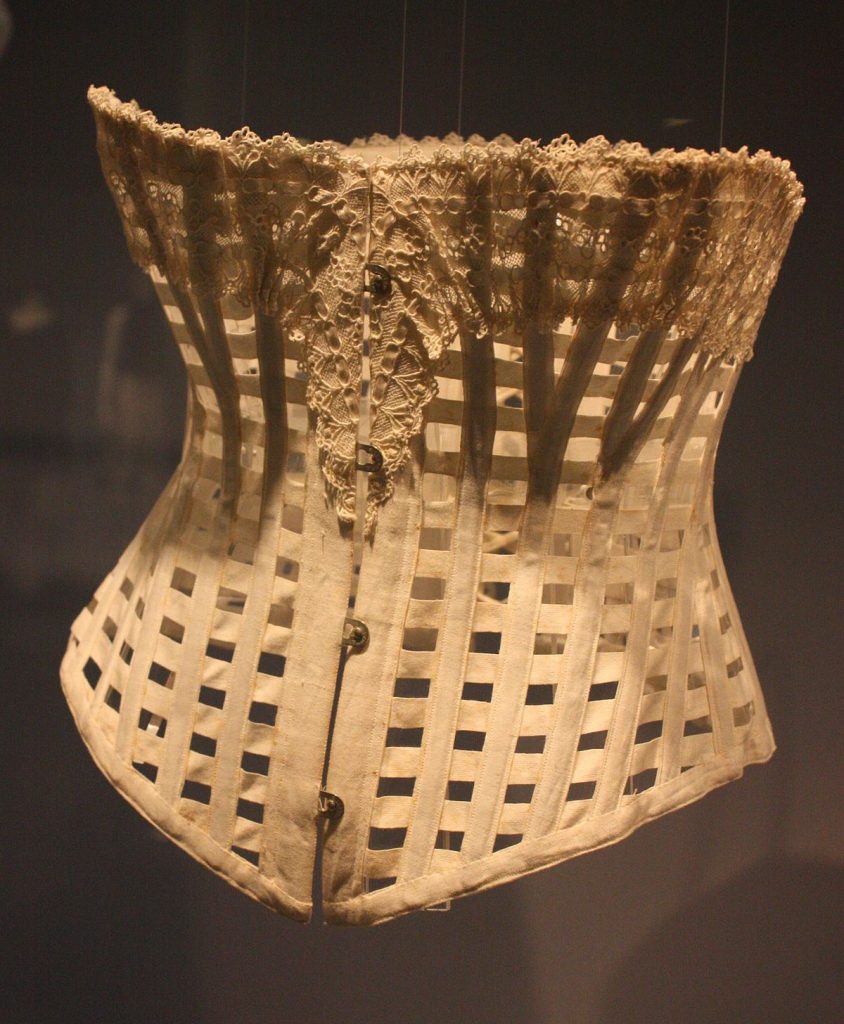
Silhouette
Silhouette went through some significant changes over the years. These changes occurred due to the changes in undergarments. Earlier women wore Crinoline with at least six layers petticoats made from linen-like fabric. The fabric was woven from horsehair.
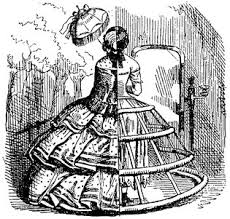
Later cage crinoline was developed. These made women free from those heavier petticoats. Bustles or Tournures then replaced crinoline. Bustles were padded undergarments worn under the skirt below the waist. These helped the skirt from dragging.
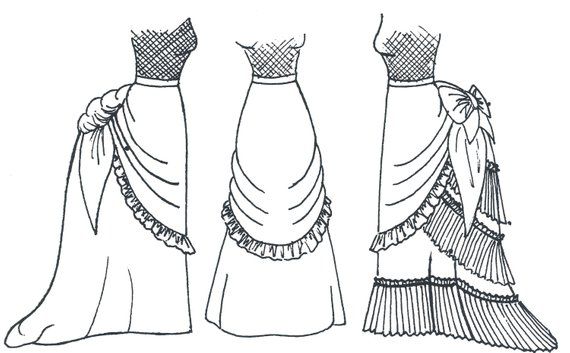
Victorian Women’s Clothing Timeline
The timeline of Victorian women’s Clothing is well documented. There are both minor and significant changes from one decade to another.
1830:
At the beginning of the Victorian era, women wore tightly laced corsets and bell-shaped skirts. The ideal woman shape was a long slim torso along with wide hips. To achieve a narrow waist, women wore a tight corset. Over the corset, they wore a tight-fitting low waistline bodice. The neckline was low and straight. Women wore a small cut chemise under the corset. It helped them to prevent exposure. The more flares in gowns, the better.
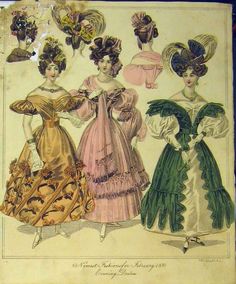
1840:
In the 1840s, women’s clothing saw changes in necklines, sleeves, bodices, and skirts. The neckline was low and slightly curved. The sleeves were tight in the top but extended in the elbow and wrist. The bodices were elongated V shape bodice. The side of the bodice stopped at the natural waistline. The extra layer of petticoats and flounces increased the fullness of the skirts. The width of the skirt increased due to the horsehair crinoline. This type of crinoline became a status symbol of wealth. The length of the skirt also increased during this decade.
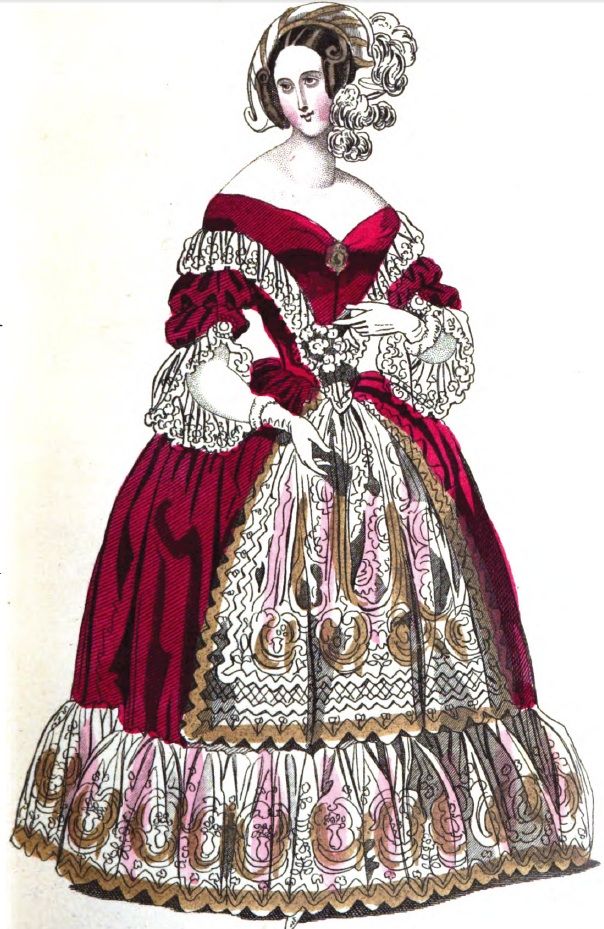
1850:
The clothing went through minor changes in this decade. The silhouette remained almost the same. But some elements of the garments and design changed. The neckline dropped even lower. The neckline was a deeper V-shaped neckline.
The skirts expanded further because of the caged crinoline. This caged crinoline created a false illusion of an hourglass silhouette. This cage crinoline made the dress lighter. The lighter clothing and increased volume of crinoline made movement easier for women. The invention of the synthetic dye added new and brighter colors to the clothes.
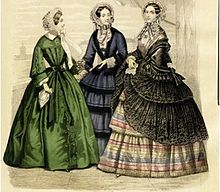
1860:
During the 1860s, crinoline began to decrease in size. The top decreased significantly. The front became flatter. But the back became more voluminous. The bodice ended at the waistline. It had wide pagoda sleeves. At the end of this decade, the crinoline was replaced by the bustle. The skirts then lost their fullness.
Women wore both high and low neckline dresses. The high neckline collar was for days, and the low neckline was for evening dresses.
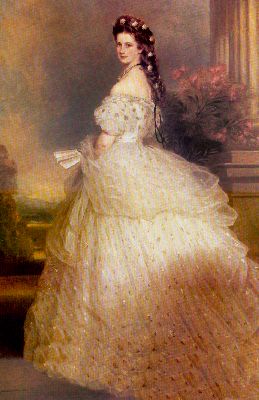
1870:
Women’s clothing went through a lot of changes during the 1870s. The silhouette became slimmer. The neckline varied. The bodice remained at the natural waistline. In 1873, polonaise made its way to Victorian women’s clothing. The polonaise had a bodice and an overskirt together. Women also wore tournure with the polonaise.
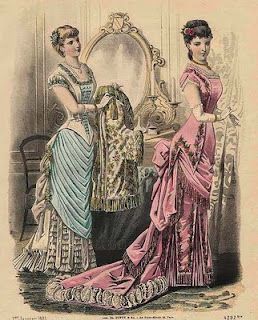
1880:
During the 1880s, the clothes started to become more practical in design. Cloths with natural silhouettes, lightweight underwear made their way into women’s clothing. The tight corset began to disappear, and women favored practical clothing over aesthetics.
The bustle made a reappearance in 1883. But during 1886, the silhouette turned back to the slimmer design again. The sleeves were thinner and tighter. The neckline became higher.
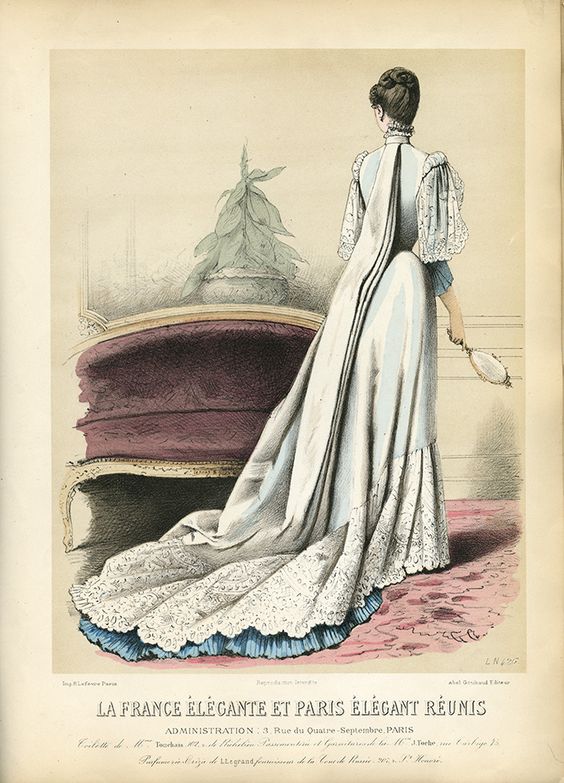
1890:
During the 1890s, the skirt flared away from the waist. This gave the skirt kind of a bell shape. The crinoline and bustle were abandoned. The neckline was high. The sleeves were long. At the end of this decade, women began to wear a tailored jacket.
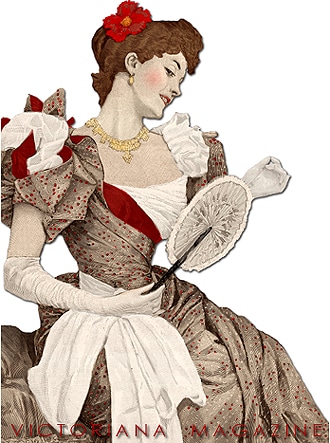
Victorian Fashion Men’s
Men during the Victorian era wore various types of coats, shirts, ties, trousers, and hat. The Victorian era men’s fashion trends are not as thoroughly documented as women. But there is still enough information about men’s clothing choices over the decades.
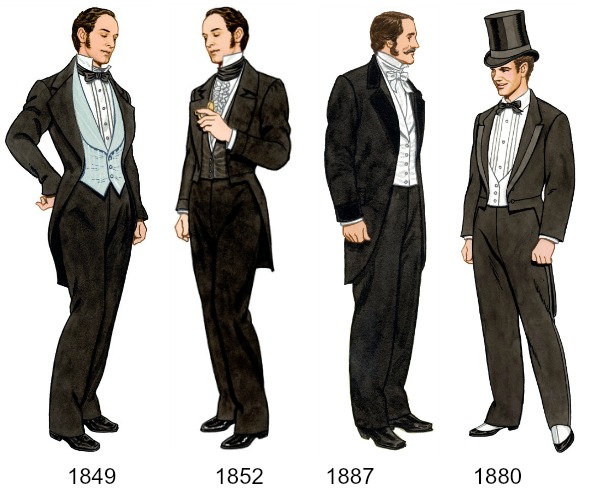
Victorian Men’s Clothing Timeline
The men’s clothing had its fair share of evolution and changes. Every decade saw some changes in men’s clothing during the Victorian era.
1840
In this decade, men wore tight-fitting long frock coats. The coats were calf length. Under the coat, they wore a vest or waistcoat. The shirts are linen or cotton shirts with low collars. They occasionally wear cravats or neckties. Men wore a top hat with wide brims during this decade. This kind of top hat protected them on sunny days.
1850
In the 1850s, the shirt had a turnover collar. They used a necktie and bow. The upper-class men wore a top hat, and the working-class men wore bowler hats.
1860
During the 1860s, the top hat became a very tall stove pipe-shaped hat. The frock coat became shorter. Men wore them for business meetings. For a formal occasion, men wore sack coats. Sack coats are mid-length tight coats.
1870
The frock coats and sack coats became shorter during 1870. Men started to wear a three-piece suit with patterned shirts. Men wore both neckties and ascot ties during this decade.
1880
Earlier this decade, the formal evening dress was a dark tailcoat and trousers with a tan vest. The shirt had winged collars. Men wore a white bow tie for formal occasions. During winter, men wore either knee-length top coats or calf-length overcoats.
1890
In the 1890s, blazer made its way to the market. Blazers were worn in many casual activities like sports and sailing.
Children’s Clothing
The upper-class girl wore frocks like tailor-made clothes. Before school, the girl wore very frilly dresses. Aside from that, they also wore densely layered skirts and dresses. The skirt length increased with their age. Some young girls wore bonnets over their heads.
Little boys wore sailor suits and tartan. The shirt was white linen shirts. Sometimes they wore a vest over their shirt. Boys wore straw hats and caps during the Victorian era.
Sometimes both girls and boys below the age of five were frocks. Because it was easier for their nanny to change their clothing, both boys and girls wore buttoned-up boots.
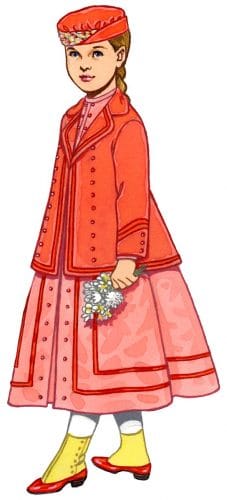
Victorian Era clothing poor
The Victorian era was a class-based society. The poor women and children wore different types of clothes than upper-class people.
The poor Victorian men’s clothing was kind of similar to the upper-classmen. They wore various types of coats, shirts, and trousers. But their clothes were old and wrecked. Most of their clothes were from a second-hand shop. Some poor men wear bowler hats. They had to wear practical clothes for their works. They usually wore heavy boots with the thick hobnailed sole. These shoes lasted over a long period of time.
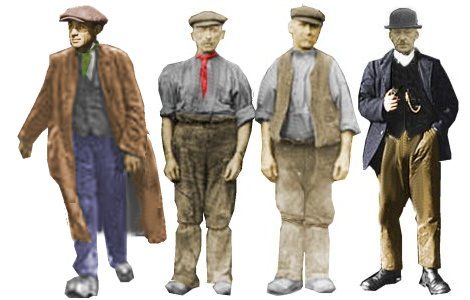
The poor women’s clothing was much different than upper-class women. Unlike rich women, poor women had to work in households and other places. Their cloth was more practical than the fabrics of rich women. They covered their hair to protect their hair. Poor women rarely wore any shoes.
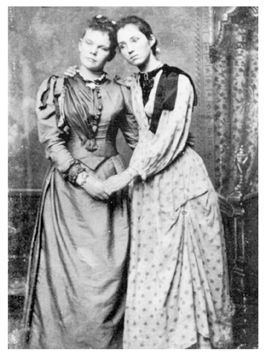
The children also wore wrecked tattered cloth. Their clothes were handed down from the older members of the family.
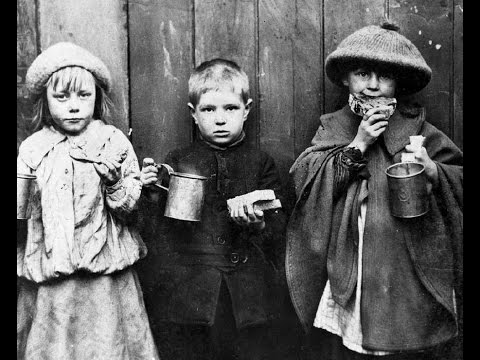
Hair Style
The upper-class women usually kept long hair. They oiled their hair for a smoother look. Their hairstyle was a symbol of their elegance.
Men’s hair was short, with a wide variety of facial hairstyles. The common forms of facial hair were mustaches, sideburns, and full beards. The clean, shaved look became popular in the latter part of the Victorian era.
Shoes
Women were various types of shoe during the Victorian era. Earlier, women wore narrow and heelless shoes. During the 1850s, the shoes were slightly more comprehensive. The heel was low and made of leather or cloth. In that time, buttoned and ankle-length laced boots were fashionable too. From the 1870s, the shoes had high heels and pointy toes.
Victorian men wore boots with hooks or laces. The boots had narrow toes and elastic sidings. During the 1870s, many men wore rubber and canvas shoes. They were famous for playing tennis. At the end of the Victorian era, low cut pump shoes made their way into the market.
Conclusion
The Victorian era brought a timeless, unique, and aesthetic fashion trend to Britain. That era has a lot of influences, even in modern times. People are still curious about Victorian fashion clothing trends. The cloth design and look of that era were impressive. The clothing went through necessary changes and became more useful over time. Victorian era’s clothing reflected that era’s artistic visual presentation. Without any doubt, Victorian fashion was a work of art.

